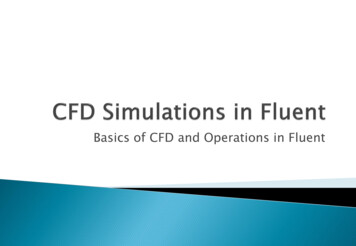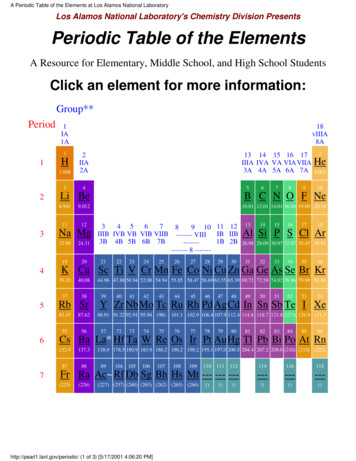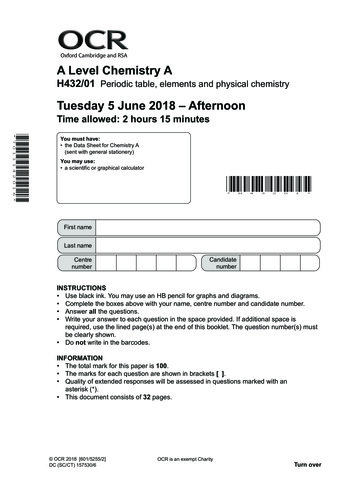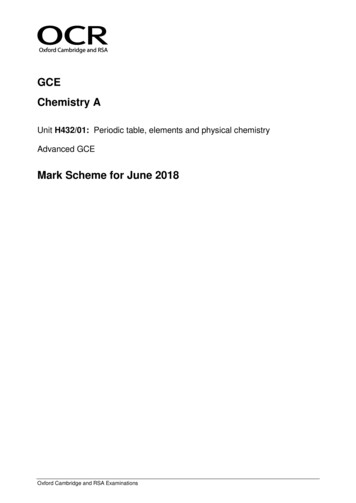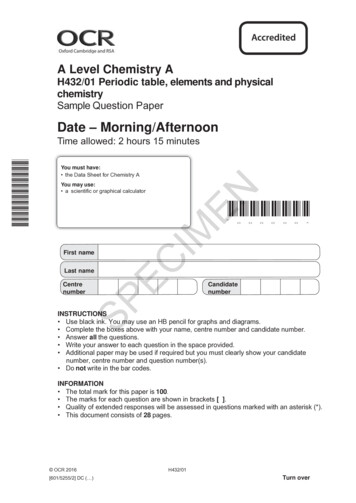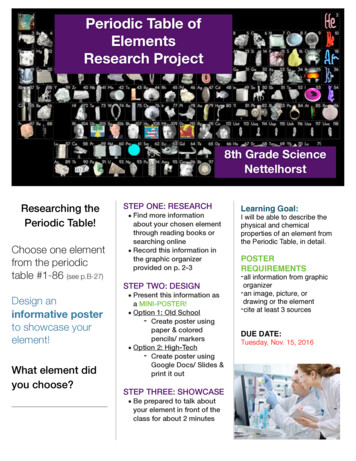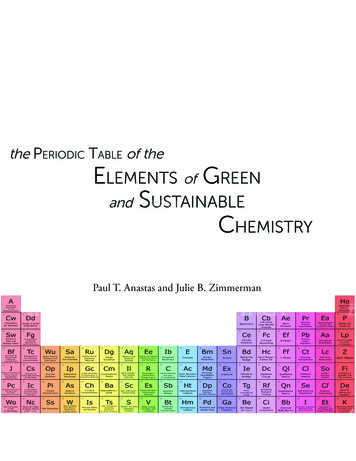
Transcription
THE PERIODIC TABLE OF THE ELEMENTSOFGREEN AND SUSTAINABLE CHEMISTRYPaul T. AnastasJulie B. Zimmerman
The Periodic Table of the Elements of Green and Sustainable ChemistryThe Periodic Table of the Elements of Green and Sustainable ChemistryCopyright 2019byPaul T. Anastas and Julie B. ZimmermanAll rights reserved. Printed in the United States of America. No part of this book maybe used or reproduced in any manner whatsoever without written permission exceptin the case of brief quotations embodied in critical articles or reviews.For information and contact; address www.website.comPublished by Press Zero, Madison, Connecticut USA 06443Cover Design by Paul T. AnastasISBN: 978-1-7345463-0-9First Edition: January 202010 9 8 7 6 5 4 3 2 1
The Periodic Table of the Elements of Green and Sustainable ChemistryTo Kennedy and Aquinnah3
The Periodic Table of the Elements of Green and Sustainable ChemistryAcknowledgementsThe authors wish to thank the entirety of the international green chemistry community for theirefforts in creating a sustainable tomorrow.The authors would also like to thank Dr. Evan Beach for his thoughtful and constructivecontributions during the editing of this volume, Ms. Kimberly Chapman for her work on thegraphics for the table. In addition, the authors would like to thank the Royal Society of Chemistryfor their continued support for the field of green chemistry.4
The Periodic Table of the Elements of Green and Sustainable ChemistryTable of ContentsPreface. 7Introduction. 9Humanitarian Elements. 10Green Chemistry and Green Engineering.24Prevent Waste. 26Atom Economy.31Less Hazardous Synthesis. 36Molecular Design .41Solvents/Auxiliary Chemicals. 46Energy.51Renewable Feedstocks. 56Catalysis. 61Degradation. 66Measurement and Awareness. 715
The Periodic Table of the Elements of Green and Sustainable ChemistryEnabling Systems Conditions.76Conceptual Frameworks.78Economics and Market Forces. 85Metrics. 92Policies and Regulations. 99Tools. 106Noble Elements. 113Valency. 122Conclusion.123Bibliography. 1246
The Periodic Table of the Elements of Green and Sustainable ChemistryPrefaceThe field of Green Chemistry emerged in the early 1990s as an approach to using the powerand potential of chemistry to design the next generation of products and processes such thatthey are good for humans, the environment, society, and the economy. Its innovations are feltaround the world in improving the products of our daily lives, the way we make our medicinesand grow our food, and how we generate and store our energy. In recent years, sustainablechemistry has been introduced to describe those important aspects beyond the science thatare necessary for green chemistry to make a positive impact on the world at the scale andtimeframe necessary to advance sustainability.In celebration of the 150th anniversary of the Periodic Table of the Elements, a new metaphoricalconstruct has been assembled to illustrate the “elements” that will be crucial on the path toa sustainable future. This is the basis of “The Periodic Table of the Elements of Green andSustainable Chemistry.”7
The Periodic Table of the Elements of Green and Sustainable Chemistry8
The Periodic Table of the Elements of Green and Sustainable ChemistryIntroductionWhen thinking about the brilliance of how creative chemistry has transformed civilizations interms of volume and efficiency of food production, access to energy, invention of new medicines,ability to travel far distances, and the insights gained through its role in the information revolution,one soon recognizes why chemistry is often referred to as “the central science”. But certainly,it is not merely central to various industrial sectors or central to enabling a range of academicdisciplines. It must be central to more than just that.What it is central to is perhaps the most important question of our time. Because when recognizingthe fundamental nature and the power of chemistry, we recognize that it is central to whetherwe will meet the greatest challenges of current and future generations. When considering thegreat urgent goals of sustainability, chemistry is central to the difference between success andfailure, survival and extinction. It is that fundamental.In recent decades, the field of green chemistry has emerged with all of its technological andcommercial achievements, with all of the new perspectives that green chemistry brings, all ofthe new inventions and innovations, new reactions and transformations of forms of matter, andthe motivation and impetus behind all of this activity becomes clear. We find the answer to thequestion: “Why do we do what we do?”And at the foundation of everything we do are the humanitarian issues, the humanitarian goals,the human species and the ecosystems, biosphere, and geosphere upon which the humanspecies relies.9
The Periodic Table of the Elements of Green and Sustainable ChemistryHumanitarian ElementsThe following elements of Green and Sustainable Chemistry emphasizecore humanitarian aims and principles. Since chemistry has existed as adiscipline, it has played a central role in meeting fundamental human needs.As we continue to press against the limits of natural systems, it will remaina challenge to ensure basic needs such as food, water, security, and shelterfor future generations. Green and Sustainable Chemistry should also striveto ensure that risks and benefits are equally shared among populations.10
The Periodic Table of the Elements of Green and Sustainable ChemistryAppropriate Technologies for the Developing WorldThe invention and deployment of chemical technologies over the pasttwo centuries has transformed modern life for a segment of the globalpopulation. However, many of the technologies developed in the past andstill being developed today are not benefiting or improving the well-beingof a large percentage of the world’s population. This is due to factors thatinclude particular resource flows, capital flows, infrastructure requirements,human capital, and more.Developing appropriate technologies means understanding the context inwhich a technology will be deployed to ensure that it can bring benefit.Designing a technology to be viable in the industrialized world or thedeveloping world, a major metropolis or a tribal village, requires systemsthinking and thoughtful design. Designing technologies for the appropriatecontext is a challenge that needs to be met if benefit is to be equitable.11
The Periodic Table of the Elements of Green and Sustainable ChemistryChemistry for WellnessChemistry has been at the forefront of modern Western medicines withthe vast majority of effort focused on treating disease. However, treatingdisease is not the same as preserving wellness. Chemistry has been atthe forefront of increased food production. However, increased food supplyand production of caloric content is not the same as the realization ofaccess to nutritional health. Chemistry has been at the forefront of imaging,diagnostics, and sensors but measuring and monitoring a problem is not thesame as solving it or preventing it. Chemistry can play a role in significantand timely efforts to rigorously understand and deliver nutraceuticals,probiotics, and other beneficial supplements. Chemists also need to worktoward elucidating and enhancing positive mechanistic pathways towardproactive health.12
The Periodic Table of the Elements of Green and Sustainable ChemistryAccess to Safe and Reliable WaterOne of the essential materials of life is water. Access to suitable water fordrinking, sanitation, and hygiene is necessary for life, health, and well-being.Chemistry has been critical in historical approaches to water disinfectionand improving water quality from removal of harmful contaminants toaddressing odor and taste concerns. Chemistry will be required to realize thefuture methods, process, and materials that enable healthful drinking waterwithout the unintended consequences of harmful disinfection by-products.Sanitation is an equally important imperative to avoid the spread of diseaseby exposure to pathogens. These services must be supplied in ways thatare mindful of equity, safety, and dignity. The enabling infrastructure andprocesses for supply and treatment of potable and non-potable water willall depend on chemical innovations to ensure appropriate quantity andquality for drinking, sanitation, hygiene, or any other intended use.13
The Periodic Table of the Elements of Green and Sustainable ChemistryChemistry for Benign Food Production and NutritionWhile the great increases in the efficiency of food production have beenastounding and life-saving, there have been unintended consequencesfrom the over-use of fertilizers and the use of pesticides and herbicides thatharm beneficial insects and plants and damage ecosystems.Chemical and non-chemical alternatives are being developed and need tobe implemented at larger scale. These range from targeted bio-pesticidesto herbicides that focus on specific pests and plants to pesticides designedto degrade rapidly into non-toxic degradation products. Integrated pestmanagement systems have been shown to be efficacious and economicallypractical without the environmental damage.14
The Periodic Table of the Elements of Green and Sustainable ChemistryEnsure Environmental Justice, Security, and EquitableOpportunitiesProximity to chemical manufacturing, processing, and use has historicallycome with disproportionate risk to the surrounding communities andecosystems; this includes the exportation of banned chemicals andhazardous waste to communities with few other economic opportunities.Individuals should have the right to live in homes and communities that arenot placed at increased risk due to transportation or production of chemicalsor inadequate protection of facilities. Use of highly hazardous chemicalsincreases vulnerability to accidents, natural disasters, or intentional acts ofviolence and terror. Adopting chemistries that are inherently benign is themost effective means of ensuring that communities are not placed at unduerisk from the chemical enterprise. Case studies have shown that there aresafer alternatives to toxic gases, VOCs, pesticides, and cleaning chemicalsimplicated in previous incidents.15
The Periodic Table of the Elements of Green and Sustainable ChemistryChemistry to Preserve Natural Carbon and OtherBiogeochemical CyclesIntegrated systems are the basis of the planet’s natural biogeochemicalcycles. From carbon to nitrogen to water and beyond, these chemical cyclesand chemical processes are adversely impacted by the human interferencesand interactions with these cycles. Human chemistry must be designedsuch that there will be no perturbation of the natural biogeochemical cyclesand their interlinkages. Through thoughtful consideration of human materialand energy utilization, we can protect the critical natural cycles essential tothe preservation of life and all of its diversity on the planet.16
The Periodic Table of the Elements of Green and Sustainable ChemistryNo Chemicals of War or OppressionThe history of the intentional use of weaponized chemicals is recognizedas uncivilized and the continuation of the universal rejection of this practiceis essential to a civilized society. Likewise, the use of chemicals for carryingout the death penalty or for the oppression of individuals through chemicallobotomies or chemical castration must not happen. Designing, making,and utilizing chemicals for the purpose of mental or physical control overindividuals is inconsistent with the peaceful uses of chemistry.17
The Periodic Table of the Elements of Green and Sustainable ChemistryDesign to Avoid DependencySome molecules can be addictive to humans. They can cause physicaland neurological changes that result in dependency, and its subsequentimpairment. Chemists have the duty to establish knowledge and awarenessof the mechanisms of dependency in order to ensure that the moleculesthat are created do not result in human dependency and addiction.Economic dependency is a separate yet important issue. Molecules shouldnot be designed to be essential and inseparable to livelihood and wellnessand embedded in systems that provide critical items like food, clean water,and medicine.Chemical dependency is not limited to the human species; it can alsoimpact other living things both animal and plant. Dependency needs to beunderstood such that design for variety and resilience is pursued preferably.18
The Periodic Table of the Elements of Green and Sustainable ChemistryEnsure Access to Material Resources for Future GenerationsThe basic elements will largely not be created nor destroyed – with theexception of radioactive decay. However, the ability to access resourcesthat are fundamental to the chemical and material infrastructure of oursociety and economy can be greatly impacted and diminished throughirresponsible use. The combustion of valuable fossil fuels, the dissipation ofphosphorus, and the diffusion of rare earth elements will make our resourcebase more difficult to access for future generations.19
The Periodic Table of the Elements of Green and Sustainable ChemistryTransparency for Chemical CommunicationThe potential benefits and the potential harm that can be provided bychemistry are too immense and powerful to be cloaked in the darknessof jargon. Yet, as the evolution of chemistry proceeds, the greater theopacity of the science to the general public. The responsibility of molecularscientists – and scientists generally – is not merely to discover, invent, andunderstand, but also to effectively convey that understanding as clearlyand transparently as possible. To be clear, this is not the same as “asclearly and transparently as convenient.” The task of communication isnot a secondary task but rather one of equal status in the scientific pursuit.20
The Periodic Table of the Elements of Green and Sustainable ChemistryChemistry for Sustainable Building and BuildingsThe structures that are used to house people and their activities shouldbe designed, constructed, and maintained to provide resilient protectionwhile being conducive to the health and wellness of the occupants andthe surrounding ecosystems. From the molecular basis of the materialsthroughout their life cycle to the systems that provide the requisite water,climate control, and lighting, chemistry has a significant role to play inefficiently providing safe indoor environments for humans and their activitieswhile considering the surrounding landscape. Further, buildings can bedesigned to be modular, providing for future adaptions, deconstruction, andreuse to avoid end of life material waste.21
The Periodic Table of the Elements of Green and Sustainable ChemistryAn Individual’s Molecular Code Belongs to that IndividualEvery individual possesses the unique molecular code that is the underlyingbasis of their individuality and their identity. Further, this code has the powerand potential for understanding health and wellness in a fundamental way,at the molecular scale. While this molecular code may contain informationand functionality that can result in value, every individual is sovereign overtheir code and this sovereignty cannot be taken from them by others. Asthe ability to understand, manipulate, and utilize the various levels of thisbiological code increases, it will be ever more essential to guarantee thatcontrol of this code remains with the individual.22
The Periodic Table of the Elements of Green and Sustainable ChemistryMolecular Codes of Nature Belong to the WorldNo human wrote any of the genetic codes of Nature and no human or groupof humans can own it. Humans played no role in the billions of years of thedesign of genomes, bio/geo material structure, natural transformations andself-assembly. The inventions of Nature belong to Nature. The codes ofNature belong to Nature. The act of a human recognizing its brilliance anddeeming it a discovery is not justification to claiming ownership and controlor in any way limiting access to this brilliance by everyone.23
The Periodic Table of the Elements of Green and Sustainable ChemistryGreen Chemistry and Green EngineeringIn order to address the humanitarian goals that are inextricably linked to preserving our naturalworld, invention and innovation are essential. While efficiency will be necessary, it will be farfrom sufficient. Efficiency will help you do the thing you are doing better; it will not help you doa better thing. Being more efficient in our use of unsustainable resources, products, processes,and systems is not going to fundamentally alter the unsustainable trajectory we are on. Doingsomething that is unsustainable more efficiently does not make it sustainable.The design, invention, and innovation that is required is embedded in the Principles of GreenChemistry and Green Engineering. The scientific and technological breakthroughs using theseprinciples are meant to change the nature and character of the material basis of our society andour economy – including the materials used to generate, store, and transport our energy – tomake it healthful rather than toxic, renewable rather than depleting, and restorative rather thandegrading. The manifestation of these principles are the discoveries that go from the laboratoryto making a difference in the world.24
The Periodic Table of the Elements of Green and Sustainable ChemistryThis collection of science and technology is the manifestation of the Twelve Principles of GreenChemistry and the Twelve Principles of Green Engineering.25
The Periodic Table of the Elements of Green and Sustainable ChemistryPrevent WasteRegardless of its nature, waste consumes resources, time, effort, andmoney both when it is created and then when it is handled and managedat end of life, with hazardous waste requiring even greater investments formonitoring and control. Creating, handling, storing, and disposing of wasteis necessarily an expense and does not add value in terms of innovationor performance. In processes of production, therefore, waste is alwaysundesirable in any form.Ideally, molecules, products, processes and systems would be designedto not create waste. We should aim to eliminate even the concept ofwaste by ensuring that all outputs are feedstocks elsewhere, mimickingnatural systems. Whether the waste is material, energy, space, time, or thederivative of all of these, money, there are design strategies that can andare being implemented in Green Chemistry and Engineering to address theissue at the most fundamental level: prevention.26
The Periodic Table of the Elements of Green and Sustainable ChemistryWaste Material Utilization and ValorizationWaste is a human-centered concept. In Nature there is, for all practicalpurposes, no waste. In Nature, organisms and geo-systems evolveto utilize the “waste” of one process to nourish, sustain, and strengthenanother. While the history of human-designed chemical systems has beenlinear (e.g., take-make-waste), there is a recognition that genuine elegancerequires the building of circular systems where materials and energy flowin cycles as they do in Nature. This depends on developing the tools,techniques, and approaches for “designing waste” such that the “waste”itself is considered an additional product of the system.These approaches of chemical waste valorization have found large-scaleapplication in a variety of settings from individual product manufacturingprocesses to entire mega-scale factories to urban and regional networks.Transforming waste into a value-added product is a science in its infancyand it will need to develop considerably in sophistication and scale in orderto displace the wasteful linear processes that have historically dominated.27
The Periodic Table of the Elements of Green and Sustainable Chemistry“One-Pot” SynthesisWhen chemical transformations have taken place historically, they haveoften required many steps, especially for complex molecules such as thosein the field of pharmaceuticals. Each time there is a multi-step synthesis,there is the need for separation, isolation, and purification that results in lossof material, increased energy usage, and time lost.Where possible, chemists should aim to design “one-pot” synthesis, inother words, transformations that can be carried out in a single reactionvessel without isolation, purification, or other wasteful steps. These moreefficient processes must also avoid potential tradeoffs such as relyingon more toxic substances or generating lower quality products. Whenimplemented carefully, fewer steps and fewer reaction vessels can providesignificant benefits in efficiency and waste reduction.28
The Periodic Table of the Elements of Green and Sustainable ChemistryProcess IntensificationTraditional methods of chemical manufacturing have intrinsic inefficienciesthat result in wastes of materials, energy, time, and space. Throughthoughtful redesign, entire manufacturing processes that had been split intolarge numbers of “unit processes” of reaction, separation, purification, etc.,can be combined. The benefit is not merely waste reduction but also lowercapital and operating costs while increasing inherent safety. The concept ofhaving small continuous-flow “reactors” that can be increased in number,so-called “numbering up,” can realize these advantages compared toconventional “scaling up” of bulk processes.29
The Periodic Table of the Elements of Green and Sustainable ChemistrySelf-SeparationThe chemicals and materials enterprise is one of the major consumersof energy in industry. One very large piece of this energy consumptioncomes from separation processes, encompassing isolation, purification,and some kinds of cleaning. In addition to the energy that is directly inputinto traditional separation systems, the dependency of these processes onlarge volumes of solvents also consumes significant amounts of embeddedenergy from solvent manufacturing and purification.Systems designed to facilitate “self-separation” can decrease energy andmaterial usage when developed properly. Designing a molecular productto separate from its reaction matrix or enabling an impurity generated ina process to self-separate due to intrinsic factors can have sustainabilityadvantages.30
The Periodic Table of the Elements of Green and Sustainable ChemistryAtom EconomyThe modern miracle of chemical enterprise is the ability to transformthe materials that occur naturally in the world into new materials withnew properties and performance that would not otherwise exist. Historyhas shown there are thoughtful and wise ways to engage in moleculartransformation and there are methods that are profoundly toxic, wasteful,and depleting. The new emerging synthetic methods that have beendemonstrated in the field of green chemistry come from thoughtful lifecycle design and often use Nature and biological systems as an inspiration,mentor, and guide. Through this type of thoughtful design, we move from anarrow definition of mere efficiency to one of holistic productivity.31
The Periodic Table of the Elements of Green and Sustainable ChemistryMolecular Self-AssemblyThe process of intentional bond-making has been one of the most importantaccomplishments of chemistry. Historically, this process has often beenforced through the use of energy or reactive reagents to occur at the time,place, and rate that is desired. The more complex the molecule, the moresteps and energy that has often been employed.Looking at natural and biological systems, there are many examples wherecomplex molecules with extensive stereochemistry and intricate ringsystems are realized through molecular self-assembly that takes placeupon appropriate stimulus. This can be achieved in human-designedsynthesis as well. It is, of course, always important to not simply designa self-assembling molecule by shifting the energy and reagent inputs toanother part of the product life-cycle such as its precursors.32
The Periodic Table of the Elements of Green and Sustainable ChemistryIntegrated ProcessesLong chains of unit reaction processes accumulate energy and materialwaste due to the separation, isolation, and purification steps usuallyencountered after each step. These transitions are among the mostenergy-intensive aspects of an overall process. There are almost alwaysmaterial losses due to transfer from a reactor to another process step. Bydesigning processes to be integrated to the highest feasible degree, therecan be significant advantages not only for energy and material efficiencies,but also for the time saved and reduced exposures to chemical workers.It can be valuable to integrate not only individual processes but numerousprocesses as well to accomplish goals such as utilization of waste heat/material from one process as a feedstock for another.33
The Periodic Table of the Elements of Green and Sustainable ChemistryAdditive SynthesisThe use of addition reactions can significantly decrease intrinsic wastegenerated by the synthetic method. By building up a molecule atom byatom or fragment by fragment, chemists use only what is necessary inconstructing the target. It is essential to be thoughtful about not simplyshifting the burden of waste from one step to another step or another partof the process, but wisely employing addition reactions has benefits overelimination and substitution reactions that inherently generate waste aspart of the nature of the reaction.Conceptually, the addition reaction can be translated beyond the molecularscale. For example, additive manufacturing is similarly beneficial for largerscale material assembly and applications.34
The Periodic Table of the Elements of Green and Sustainable ChemistryNon-Covalent Derivatives / Weak Force TransformationChemists have pursued the mastery of bond-making with for more than200 years with great success. However, we should note that Natureaccomplishes impressive functional modifications and performancenot only through covalent bonds but also extensively using weak-forceinteractions. These weak forces engage at the time and place necessary toimpart useful properties precisely when and where they
The Periodic Table of the Elements of Green and Sustainable Chemistry Humanitarian Elements The following elements of Green and Sustainable Chemistry emphasize core humanitarian aims and principles. Since chemistry has existed as a discipline, it has





